ORDINARY BEAUTY, MODEST MIRACLES:
Max’s Travel Journal, summer ’08
St. Louis, then to New Orleans via Amtrak.
Finally, LA via Amtrak, too.
CHAPTER FOUR:
New Orleans—Parts Seem "Easy" Again
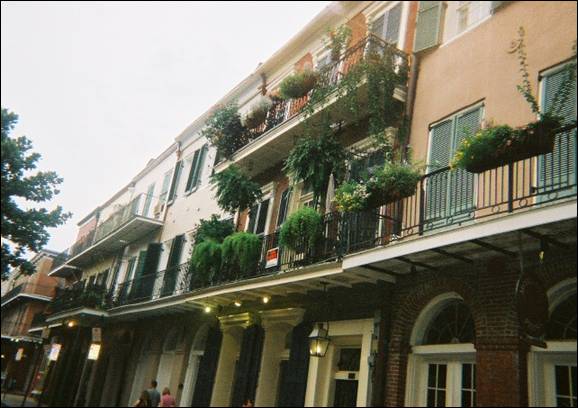
The kind of graceful architectural ambience that accounts for the great charm of the French Quarter.
I was struck, as we rolled into New Orleans, by how the city, at least the parts we past, were thriving. Though Bob suggested that if I have time, I take a trip out to the 9th ward tomorrow (I don’t think I will have time) to see first-hand the devastation the hurricane wrought, here there was really very little evidence there had been a major disaster in the past three years. What I saw was a lush, semi-tropical city with banana trees and palms waving greenly, one with a whiff of third-world ambience, but one that was also a great American center of commerce and industry.
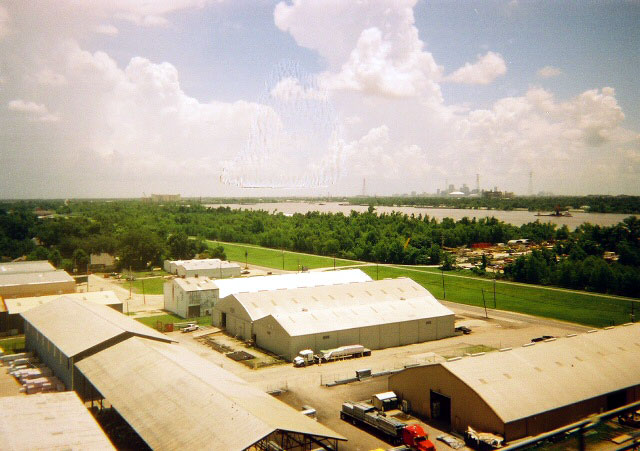
an industrial area of New Orleans near the Mississippi
I planned to take a taxi from the station to my hotel in the French Quarter, but when I asked the taxi master at the station, he said I'd be able to walk it. Having been sitting for the past fourteen hours, and wanting to see the central business district as well as the French Quarter, I followed my eager feet, pulling my bag behind me.
Three years after Katrina, downtown appeared prosperous, though the area was almost deserted after business hours. Tall skyscrapers and lovely, green plazas adorn Loyola Street. I recognized broad Canal Street from a distance by its streetcar tracks, remembering it from a visit here during my high school years. Looking across it, I could see blocks and blocks of low buildings with wrought-iron balconies—I'd arrived! Entering the French Quarter, I was immediately charmed. It really does have a “foreign” feel.
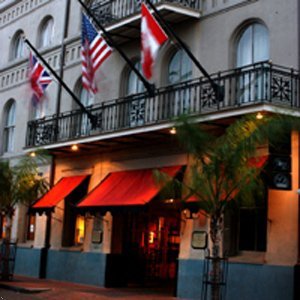
the Prince Conti Hotel
A few blocks down, I passed a sign reading Conti Street. Turning onto it, I came in a few more blocks to the Prince Conti Hotel, the elegant-looking, but inexpensive establishment where I’d booked a room via the Internet. The place was as quaint and pleasing as it had looked in photos. In fact, I said enthusiastically to the desk clerk, "This is great!" and he replied, "Well, you haven't even seen your room yet." But it was good, too. I quickly showered, changed clothes, and went out to spend the remaining daylight time exploring.
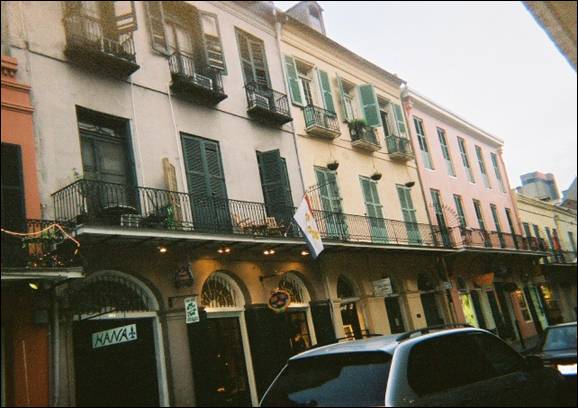
The many pastel-colored buildings in the Quarter, which is huge, also help create the nearly fantasy atmosphere.
What people “get” here, what they come to the French Quarter, a rectangular area that covers blocks and blocks and blocks, is this feeling of a kind of relaxed, colorful elegance. The wrought-iron grilles, many festooned with hanging plants; the pastel hues of many buildings; the true genius of many local musicians; the presence too, of Art, and the art of cuisine so much in evidence, all create an external image that allows people to feel these qualities internally, while they are here. It is the “brand”, the “product” of New Orleans. Who knows if there ever really was a culture or civilization quite like the “historic” French Quarter? It is a country of Imagination, and it exists here, now. I don’t blame people for coming, and I’m glad I did.
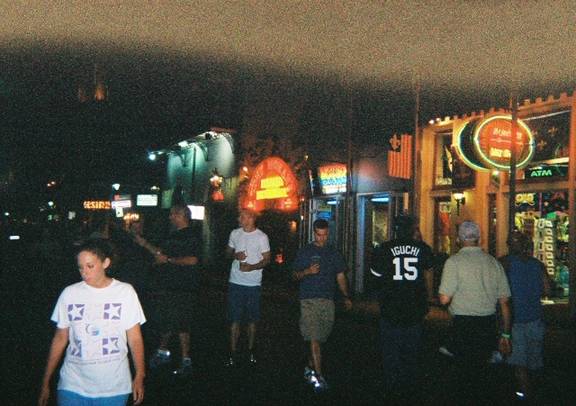
A few of the wanderers down Bourbon Street.
That said, Bourbon Street, the Quarter's "main drag", is perhaps the most obnoxiously loud street I’ve ever walked down. Its honky-tonk atmosphere, its barkers, its garish lights are a sensory bombardment as high-pitched as a state fair midway. You can practically smell cotton candy in the air, although I don’t think there is any here in the literal sense.
And yet even On Bourbon, I heard fantastic music: a trumpet solo by a man in a trio that was playing directly behind life-sized statues of Al Hirt, Pete Fountain, and Fats Domino, had Life and gave my own life a boost! It was a kind of miracle of intense creativity. Every open door seemed to have live music coming out of it, much of it very good regardless of whether it was blues, soul, or jazz. I also heard some heavy metal music that merely sounded raunchy and loud, like much of the painting in the windows and many of the trifles on sale on the street.
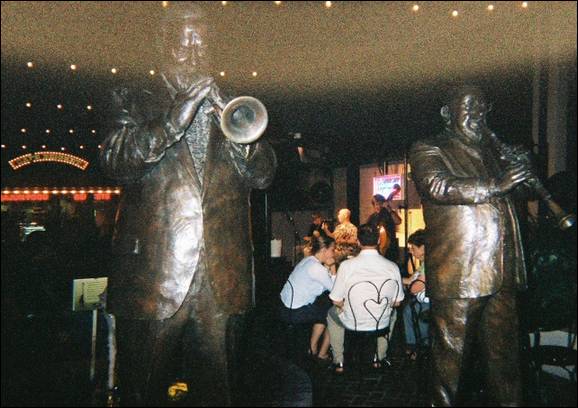
In the shadow of legends: A wonderful trio makes music in the very
shadow of these life-sized statues of Al Hirt and Pete Fountain
As I walked, I came on a block of places that had not music, but strippers. A small, pretty Asian girl stood in front of one of these establishments. For some reason, she buttonholed me.
“You should come in, sir!” she effused. I didn’t want to get involved. All I could think of to say, to get her to back off, was “I’m a married man.”
She was not dissuaded. “You should bring your wife!” she said.
“Next time,” I smiled—though not intending for a moment to bring her there.
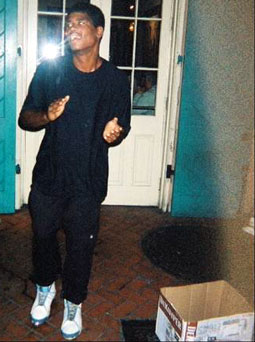
The guy above, and his brother or friend, with whom he worked, were amazing! Their street tap dancing was quite good. But what left my mouth open was when I moved way to the rear of the busy sidewalk, across the street from them, in order to take out my wallet and pull a dollar from it for them.
The very instant the tip of the green bill appeared over the top of my billfold —and let’s face it, the green on a dollar bill is not exactly bright, especially in the dark — this young man picked up his cardboard box, raced over to me, and was standing right in front of me in a few seconds! He's refined his reflexes for sniffing out money, to a degree that's practically psychic!
Turning off Bourbon and coming back along Royal Street, I heard what sounded like a full-bodied band playing Dixieland jazz. As I got closer, I saw lean, seasoned men sitting in a row, playing tuba, trumpet, clarinet, banjo, and honky-tonk piano. A boy played a rudimentary, yet satisfying percussion, keeping a regular beat simultaneously with foot pedal and drumstick.
The other instrumentalists were simply fantastic! I’d never heard trumpet, clarinet, or even tuba, played in such ecstasy! These guys weren’t famous, except maybe locally. But I’ve never been lifted higher by music.
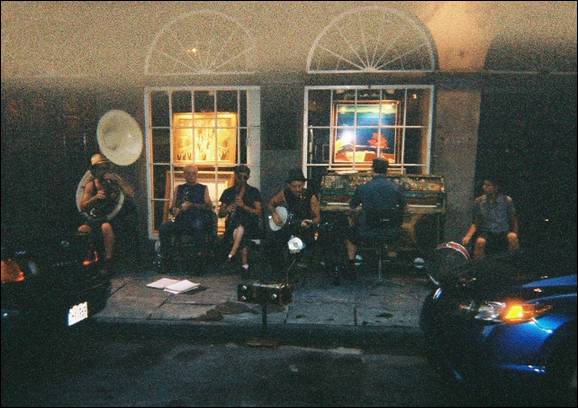
Above: The guys on Royal Street, no doubt locally famous, who thrilled me
and manyothers, and brought New Orleans “live” via cell phone, to my wife.
The trumpeter was completely bald. The tuba and clarinet players both looked tough and wore muscle shirts. The tuba guy's biceps really bulged. The jazz was only Dixieland in the way that Coltrane's "My Favorite Things" is Rodgers and Hammerstein. Each musician soared on his solo. After listening a couple minutes, I phoned Barbara and let her listen. She was enthralled, too. Since she couldn’t come to New Orleans, New Orleans had come to her.
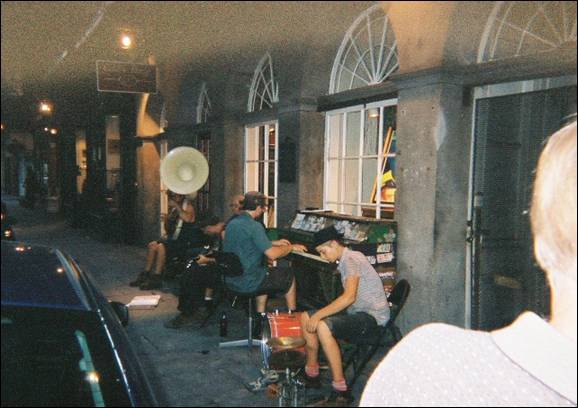
Above: Another view. Below: They got folks dancin’, too!
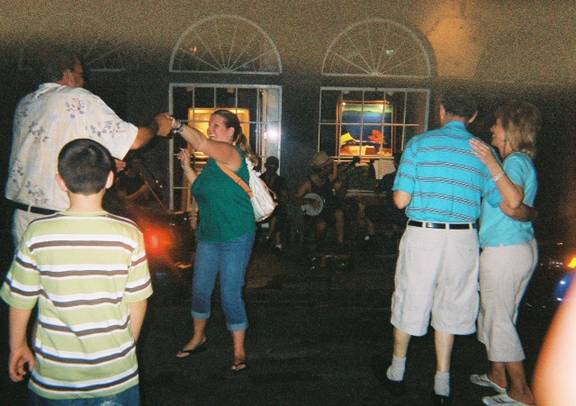
I wandered some more, around the lush Jackson Square and down to the Café Du Monde, where I'll return in the morning, when I can have coffee and not mind staying up. Then I found an Arby's on Canal and had a salad, not wishing to spend my money dining in a fine restaurant alone. After another stroll down Royal and a few other streets, I thought I'd go to Walgreens and get a diet Sprite, then go home and call it a night.
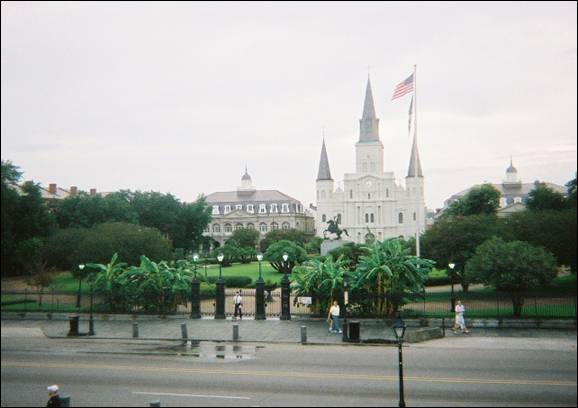
A shot of Jackson Square I took in the morning
On my way, a lady accosted me with a hard luck story. Pregnant with twins and they charge to get into all the homeless shelters. She wanted money, but I don't give money. She talked and talked. Her victim mentality saddened and eventually irritated me. I took her in to Walgreens and bought her some cold cuts, chips, and a coke, and we parted friends. I brought the Sprite back here to my room, havin had enough music and visuals for one night. I want to get all this down while it's still fresh, and I want to get up very early to make the most of my morning here.
The hotel, by the way, is picturesque, and I'm much more than satisfied. They have a continental breakfast, but I plan to go back to the
Café Du Monde. If I get there by 5 or 5:30—it's open 24 hours—I’ll have nearly seven hours before the Sunset Limited leaves for LA.
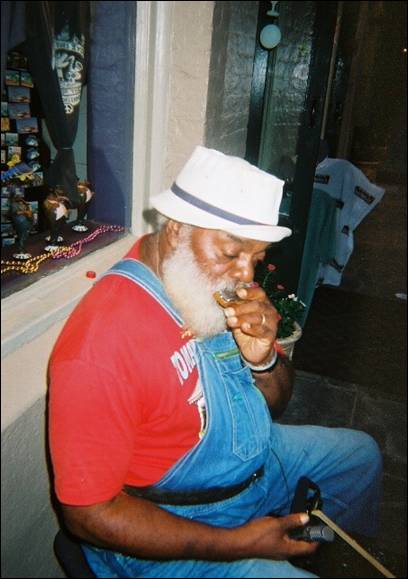
I believe this gentleman’s name is “Grandpa Eddie”. Another
French Quarter corner fixture, he plays a nice, bluesy harp.
Morning In New Orleans
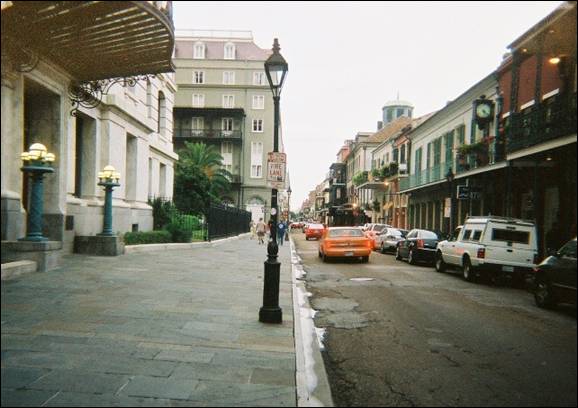
Royal Street in the French Quarter, stretching away.
At 5 AM, when I intended to get up, I realized I hadn’t slept much because the room was so cold. All night I'd pretended not to notice so as to remain snugly bundled in bed, but could not quite nod off because of the chill to my exposed face.
So I decided to slightly re-plan my day. I turned down the air conditioning, slept another hour, and got up at 6:15, still early for a tourist
I walked the half mile to the Café Du Monde and paid my four dollars for a cup of coffee and a small plate of puffy pieces of dough liberally sprinkled with powdered sugar. This was almost an obligatory activity, everybody comes here.
A man named Ed, sitting at the next table, asked if he could borrow the sports section of my Times-Picayune, which I had no intention of reading. Ed had jogged down from his hotel and had no change with him. He was in town from New England with a group of about fifty American History teachers who were visiting sites associated with the Civil Rights movement. They’d been to Selma, Alabama and Montgomery, and were in New Orleans now to interview several old-time members of the Student Nonviolent Coordinating Committee who remain active in civil rights, and learn what direction their work is taking these days.
Leaving the café, I contemplated what to do. Bob, back on the train, never one to be reticent, had suggested two different activities. There was a free ferry, he’d said, from the foot of Canal Street to Algiers, across the river. There was also a streetcar line that he said could take me out to some areas that are still devastated from Hurricane Katrina.
I was close to the foot of Canal, and as I walked toward the river I could see the ferry returning from the opposite shore. Cars were lined up to board it. But it wasn’t obvious how a person on foot was supposed to get on. And as I thought about it, I decided to take up Bob’s second suggestion instead. I’ve worked on the Mississippi, crossed it dozens of times, and used to take the Staten Island ferry to art school in Manhattan every day when I lived in New York. On the other hand, I had no experience at all seeing destruction wrought by a natural disaster like Katrina, and felt I should get a first-hand look at this other side of New Orleans.
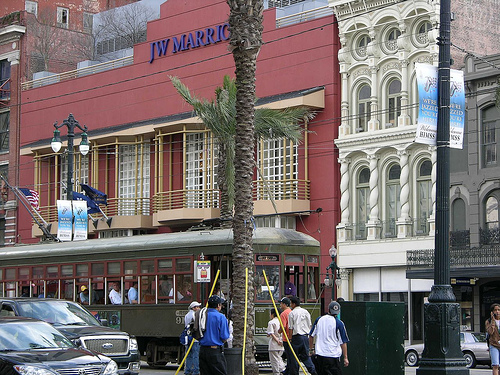
a Canal Street streetcar Brandee Crisp
A Canal streetcar was coming around the bend. I ran to catch up with it at a red light. “How much?” I asked a man waitig to board. “A dollar twenty-five. A dollar-fifty if you want a transfer." I climbed the steps and put the money in the machine. Then, standing before the driver for a moment I sputtered out my mission to find “Katrina devastation”. I felt a little silly verbalizing my disaster-tourism request, but there was no other way.
“I don’t go that far,” said the driver. “If you want to go, stay on here to the end of the line, and then take the Lake Vista bus.”
“I need to be back at my hotel in a couple hours,” I said. “Do I have enough time?”
“I don’t know. I’m not sure how regular that bus service is these days. All I can say is, that’s the way to go.”
We were several stops up Canal by now, getting past the downtown area, and I was enjoying the ride. New Orleans is the only city I know of that still keeps its old-fashioned trolleys. Is it because of the one named “Desire”? I remember the streetcars from my childhood in St. Louis. It seems a pity they were discontinued, if the story is true, simply because Firestone bought them out so America would become an automotive nation and need more of its tires.
It was 8 AM and already hot and humid. When the streetcar was going, a wonderful breeze blew through it. I felt great joy seeing more of the city outside the window, and also turning to look at the beauty of the faces my fellow passengers. The car was filling up. Every human shade of brown seemed to be represented—from dark chocolate to cocoa, to sand, with at least a dozen shades in between. Many were descended from French settlers, others from Hatians and Cubans who came here in the 1800s. So many lovely pigmentations! And they all seemed to be living harmoniously together, at least on this sunny summer morning.
The driver reached the end of the line at around 8:15. We were out by the big cemeteries, the famous ones with the big above-ground casket monuments. Everyone exited the trolley, and the driver said to follow the others to the bus shelter they were walking to, and the Lake Vista bus would come.
I followed them and then waited, and one bus finally did swing around toward us. But I looked at my watch and thought, “uh-uh”. I had made some effort at social consciousness. If I missed my train, though, I’d be in big trouble. So I started walking back down Canal Street toward the downtown. After about twenty minutes a streetcar came by and I rode the rest of the way.
What happened in the interim is that a friend in Jackson, Mississippi, whom I’d tried to reach yesterday when the train stopped there, called my cell phone and gave me the phone numbers of a couple mutual acquaintances in New Orleans. One of them was out of town, but the other—Bill—arranged to meet me after I quickly packed, picked up a few food items for the journey, and took another picturesque walk, down different downtown streets, to the station.
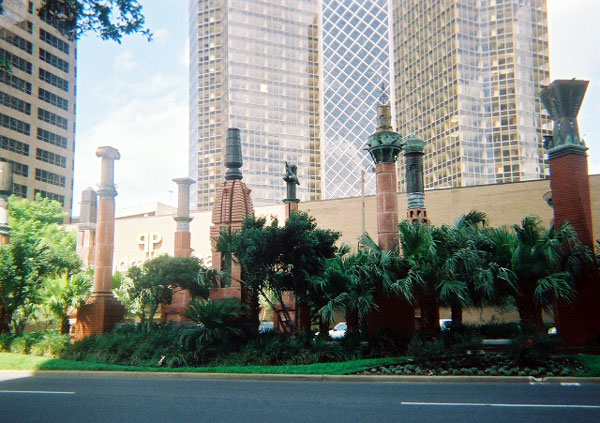 |
Cancer Survivor's Plaza on Loyola, a powerful, imaginative landmark I passed on my walks between the French Quarter and the Amtrak station. The columns, which represent different world civilizations, are only one featre of the plaza, which was funded by the man who started H & R Bloch, himself a survivor. There are parks in a number of other cities, as well. |
Bill is a long-time New Orleans resident. He posted a very moving series of reports, describing the ordeals he and his family went through during and after Katrina, to a computer list-serv we both belonged to.
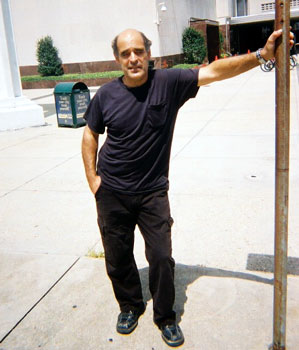
Bill Abboud: nice to “finally meet” an old friend.
It was a joy to finally meet (and put a face on) this kindred spirit. What he said, though, was sobering: that in spite of appearances to the contrary in the parts of the city I’d seen, there really is still major devastation in many other parts. Even downtown, the Hyatt Regency Hotel, whose windows I believe CNN showed "back then", blowing out, has never re-opened. The whole US economy's hitting a rough patch makes it even harder to earn a living in the city than it was before. Bill seems to be keeping his head above water emotionally, and he apparently loves New Orleans, but he says it's been hard to live there ever since the flood.
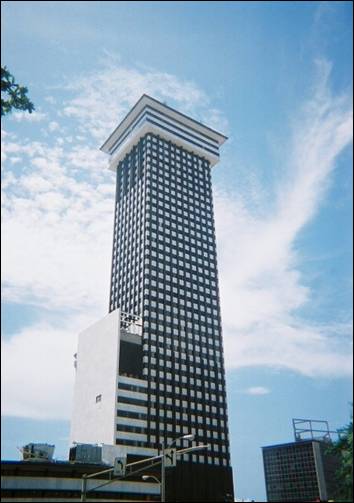
Now-vacant, unusual skyscraper.
That was my last take on things. Before Bill arrived, I'd been looking out at a pretty grove of date palms growing on the plaza in front of the Amtrak station, and out across the street past the plaza at a very tall skyscraper that looked like it had a box-top. The unusual building contributed to my exotic, "foreign city" feeling about New Orleans. In the distance beyond the center of the palm grove, the handsome, golden onion-dome of an ornate old church rose like a stamen amid the green clumps of fronds. It spoke of transcendence.
Bill shattered my "exotic" image somewhat when he told me the box-top skyscraper has been empty for several years because of asbestos and mold issues. But the former office building is about to be refurbished and eventually will re-open as the Crescent City Towers condominiums. Even Bill agreed that the city has come back, and has survived the threat to its very existence.
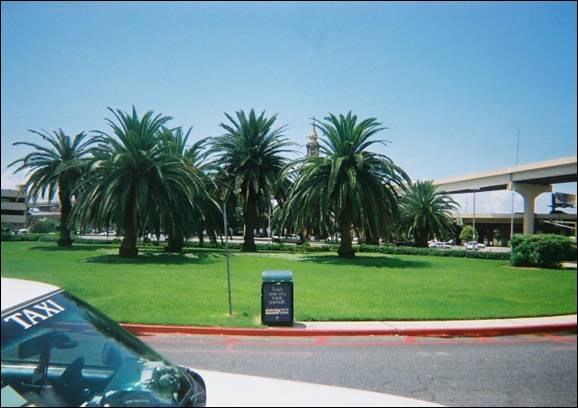
The gold cupola of an old church rises out of a grove of date palms in front of the Station.
on to Chapter Five: "The Sunset Limited": New Orleans to Los Angeles
back to Chapter Three
back to Chapter Two
back to Chapter One
back to Contents
back to Title |

















